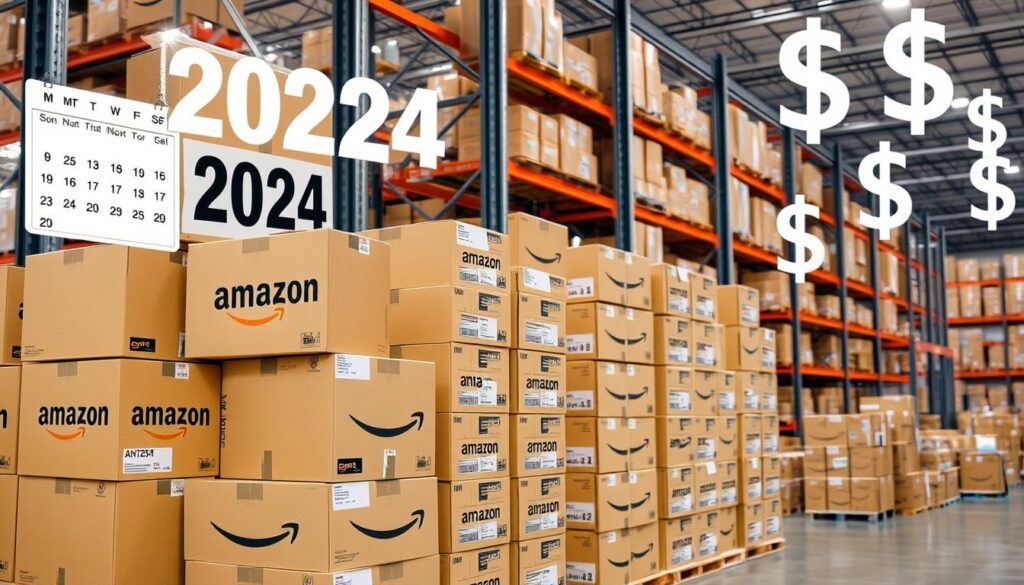Thinking about starting an Amazon business in 2024? You might wonder, “How much does it cost to be an Amazon seller?” The cost depends on your selling model, the products you sell, and how much you invest at first. Most new sellers spend $2,500-$5,000 to start, covering Amazon seller fees, product costs, and other expenses1.
But, some sellers start with as little as $500, while others invest over $10,0001. Surprisingly, those who start with less often succeed faster and stay longer. For example, 22% of those starting with $500 or less have sold on Amazon for five years or more, compared to 23% of those investing $10,000 or more1.
When it comes to making money, 66% of sellers who started with $500 or less made a profit in less than six months. In fact, 42% of them became profitable in just three months1. On the other hand, 43% of those who invested $10,000 or more took longer, between six months to two years, to make a profit1.
Understanding the costs is key to your Amazon selling journey. For instance, books have a 15% referral fee plus a $1.80 fee2. If you use Fulfillment by Amazon (FBA), you’ll also pay fulfillment fees based on product weight, size, and type. Plus, there are storage fees based on how much space your products take up in Amazon’s centers2.
By understanding your Amazon seller startup costs and making smart investment choices, you can succeed on Amazon, no matter your starting budget.
Key Takeaways
- Most new Amazon sellers invest between $2,500-$5,000 to start their business, including Amazon fees and product costs.
- Sellers who start with $500 or less often find success faster and remain on the platform longer compared to those who invest more.
- Understanding Amazon seller fees, such as referral fees and FBA costs, is crucial for planning your startup expenses.
- Profitability timelines vary based on initial investments, with many sellers who start with $500 or less achieving profitability within six months.
- Careful planning and wise investment decisions can lead to success on Amazon, regardless of your starting budget.
Understanding Amazon Seller Fees
As an Amazon seller, knowing the fees is key. These fees can affect how much you make. It’s important to think about them when setting prices and planning your business.
There are three main fees: referral fees, fulfillment fees, and monthly subscription fees. Let’s dive into each one.
Referral Fees
Referral fees are a percentage of the sale price. The rate changes based on the product type. It can be from 8% to 45%3.
For example, accessories have a 45% fee with a $0.30 minimum4. In 2024, fees for clothes under $20 went down. Items under $15 now have a 5% fee, and those between $15 and $20 have a 10% fee43.
Fulfillment Fees
Fulfillment fees are for FBA products. They cover storage, packing, and shipping. Starting February 5, 2024, new rates will apply for different sizes4.
Also, storage fees for standard-size items will drop by $0.09 per cubic foot from April 1, 20244.
| Fee Type | Description |
|---|---|
| Fulfillment Fees | Fees for storing, packing, and shipping products through FBA |
| Storage Fees | Monthly fees for storing products in Amazon’s warehouses |
| Long-Term Storage Fees | Additional fees for products stored in Amazon’s warehouses for more than 365 days |
Monthly Subscription Fees
Amazon has two plans: Individual and Professional. Individual sellers pay $0.99 per sale, while Professionals pay $39.99 monthly43. Professionals get unlimited listings and more tools3.
Other fees include the A2Z Guarantee Recovery and Amazon Shipping Chargebacks. These are for warranty cases and shipping rule violations5.
On average, sellers pay about 15% of the selling price in fees. This can be from 8% to 45% based on the category3.
Knowing these fees helps you set better prices. This way, you can make more money as an Amazon seller.
Essential Costs for Starting an Amazon Business
Starting an Amazon business comes with key costs. These can change based on your products, business model, and strategy. Let’s look at some main costs for starting your Amazon venture.
Product Samples
Investing in product samples is crucial before starting. Samples help you check product quality and appeal. On average, each sample costs around $1006.
While it adds to your expenses, samples help avoid costly errors. They guide you in making better choices.
Inventory
Initial inventory is a big upfront cost for Amazon FBA businesses. Costs range from $100 to $5006. Starting with 500 units at $4 each totals about $2,0007.
Choosing fewer items and using international suppliers like Alibaba can lower costs8.
Amazon Professional Seller Account
For selling more than 40 items monthly, a Professional Seller Account is best. It costs $39.99 a month7. This account offers more tools and saves on fees, making it a good deal for serious sellers.
UPC Codes
You’ll need UPCs (Universal Product Codes) to list products on Amazon. A single GTIN/barcode from GS1 costs about $307. Remember, each product variation needs its own UPC. Plan your budget accordingly based on your product range.
When starting your Amazon business, consider these costs carefully. Initial expenses might seem high, but nearly 40% of FBA businesses start with less than $1,0007. With smart budgeting, research, and cost-saving strategies, you can start your Amazon business successfully without overspending.
Recommended Investments for Amazon Sellers
Starting an Amazon business requires several key investments for success. The initial investment is usually under $5000. This covers costs like product sourcing, initial inventory, shipping, and fees9. Some suggest starting with $500 to $1,00010.
Amazon PPC advertising is a crucial investment. Allocating at least $10 daily for sponsored product ads can boost sales and rankings. This increases visibility and attracts more customers.
Trademark Registration for Brand Registry
Trademark registration for Brand Registry is also recommended. It unlocks tools like A+ Content, Amazon Stores, and advanced ads. These features help showcase your brand and reach more people.
Getting a professional Amazon Seller Central account is essential, costing $39.99 monthly10. It offers vital tools for managing your business. One beginner started with $1,750 for materials, inventory, courses, and software10.
| Investment | Cost | Benefits |
|---|---|---|
| Amazon PPC Advertising | $10+ per day | Generate initial sales, improve search rankings |
| Trademark Registration | Varies | Access to A+ Content, Amazon Stores, advanced advertising |
| Professional Seller Account | $39.99 per month | Essential tools and features for business management |
Most FBA sellers work less than 10 hours a week. They focus on research, marketing, and optimization9. With the right investments, most can start their Amazon FBA business in six months910.
Investing in the right tools and resources is key to success on Amazon. It’s not just about the money, but also about the time and effort you put into your business.
Additional Costs to Consider
When selling on Amazon, it’s key to know about extra costs that can affect your profit. Storage fees are charged monthly based on how much space your items take up in Amazon’s warehouses. These fees go up during busy months11. To cut down on storage costs, choose items that are in demand, small, and light. This helps save on storage time and money11.
Another cost is removal and disposal fees for items that need to be taken out or thrown away from Amazon’s warehouses. These fees can add up fast, especially for items that don’t sell well or have gone bad. Using programs like the Partner Carrier Program and Ships in Product Packaging can help lower these costs11.

Long-term storage fees are also something to think about. Amazon charges a fee for items that sit in their warehouses for a long time. This fee can be between $0.50 to $6.90+ per cubic foot12. It’s important to keep an eye on your inventory levels with the FBA Dashboard and adjust your plans as needed11.
Lastly, return processing fees can be a big expense for Amazon sellers. When a customer returns a product, you might have to pay for return shipping and a processing fee. These fees depend on the product type and why it was returned. To lower return processing fees, make sure your product listings are correct and your return policy is clear.
“By understanding and effectively managing these additional costs, Amazon sellers can optimize their profitability and build a sustainable e-commerce business.”
In short, storage fees, removal and disposal fees, long-term storage fees, and return processing fees are extra costs for Amazon sellers. By smartly managing your inventory and using cost-saving programs, you can reduce these costs. This will help increase your overall profit11.
How Much Does It Cost to Be an Amazon Seller
The cost to start an Amazon seller business varies. It depends on the product, how much you sell, and how you handle orders. On average, sellers spend $2,500 to $5,000 to begin. Some even start with just $500 and still do well.
Breakdown of Average Startup Costs
Here’s what you might spend at the start:
- Product samples: $300
- Initial inventory: $2,000
- Professional Seller Account: $39.99/month13
- UPC codes: $30
- Recommended investments:
- PPC advertising: $300/month
- Trademark registration: $250-$750
The Individual Seller account is free but charges $0.99 per item. The Professional account costs $39.99 a month but doesn’t charge per item13. Amazon also takes a fee from 8% to 45% of the sale price, based on the product category1413.
Real-World Examples of Amazon Seller Investments
Let’s look at some real examples of costs for Amazon sellers:
| Seller | Startup Costs | Monthly Expenses | Time to Profitability |
|---|---|---|---|
| Seller A | $1,500 | $500 | 3 months |
| Seller B | $3,000 | $1,000 | 6 months |
| Seller C | $500 | $200 | 4 months |
These examples show that starting with more money can lead to quicker profits. But, it’s also possible to start small and still succeed as an Amazon seller. By managing costs well and focusing on making more money, sellers can earn good profits.
“I started my Amazon business with just $500, and within a year, I was generating a steady income. It’s proof that with dedication and smart decisions, anyone can succeed on this platform.”
Understanding the costs of starting and running an Amazon seller business helps entrepreneurs make better choices. This way, they can increase their earnings and profits.
Strategies for Minimizing Amazon Seller Costs
As an Amazon seller, it’s key to find ways to cut costs and boost profits. Focus on product selection, supplier talks, and Amazon’s fee calculators. These steps help reduce expenses and grow your earnings.
Optimizing Product Selection
Choosing the right products is a big cost-cutting move. Look for items that are in demand but not too competitive. Market research and sales data can help find these gems. This way, you can avoid high referral fees, which range from 8% to 15% based on the product type15.
For example, toys and games have a 15% fee, while electronics are only 8%15. Also, consider the size and weight of products. They affect storage and fulfillment fees. Opting for smaller, lighter items can lower your storage costs and boost profits.

Negotiating with Suppliers
Another smart move is to negotiate with suppliers for better prices. Building strong supplier relationships and using bulk discounts can cut costs. This leads to higher profit margins for you.
When negotiating, know the market value of your products and their potential sales on Amazon. This knowledge helps you negotiate better deals, reducing costs and increasing profits.
Utilizing Amazon’s Fee Calculators
Amazon offers fee calculators to estimate selling costs. Tools like the Revenue Calculator and FBA Fee Preview help you input product details. They show you referral, fulfillment, and other fees.
These calculators help you make smart choices on pricing and product selection. For instance, an Individual Seller account costs $0.99 per item, while a Professional Seller membership is £25 (£28.75 with VAT) monthly1615. Knowing these costs helps you choose the best selling plan for your business.
Also, watch out for long-term storage fees. Items stored over 365 days in Amazon’s warehouses incur high fees. Amazon charges £5.51 per cubic foot or £0.11 per unit for long-term storage1615. Regularly check inventory and fee calculators to avoid these costs and keep expenses in check.
Profitability and Return on Investment for Amazon Sellers
Amazon sellers can make good money by managing their prices and costs well. With Amazon’s sales hitting $574 billion in 2023, and third-party sellers making up 23% of that, the chances for success are high.
To make more money, sellers need to know about Amazon’s fees. These include referral fees that range from 8% to 15% and FBA fees that change with the season. FBA handles picking, packing, shipping, customer service, and returns17. About 82% of sellers use FBA18.
Even with these fees, 57% of sellers make more than 10% profit, and 28% make at least 20%18. A good ROI is 100% or more, which means net profit as a percentage of product cost17.
To reach these profits, sellers must fine-tune their amazon seller pricing strategies. They should look at net margin, which shows how profitable a deal is compared to its revenue. This helps them see which products are more profitable, even if they cost different amounts.
It’s also important to consider sales volume and net margin together. This gives a clearer picture of how well a seller is doing17. With 40% of sellers making $1,000 to $25,000 a month18, finding the right price is key.
64% of Amazon sellers started with $5,000 or less, and 22% turned a profit in less than 3 months. 58% became profitable in the first year.
These numbers18 show that with good planning, amazon seller profitability and a strong return on investment are within reach for many sellers.
| Profit Margin | Percentage of Amazon Sellers |
|---|---|
| Greater than 10% | 57% |
| At least 20% | 28% |
| Not yet profitable | 13% |
Conclusion
Starting an Amazon business in 2024 needs careful thought about different costs. This includes referral fees that can go up to 45%19. There are also monthly subscription fees of $39.99 for Professional sellers20. Fulfillment fees for FBA sellers range from $3.06 to $26.33 per unit19.
The initial investment usually ranges from $2,500 to $5,000. This amount can change based on the products chosen, the amount of inventory, and extra costs for advertising and branding.
To cut costs and boost success, sellers should pick products wisely, talk to suppliers, and use Amazon’s fee calculators. FBA sellers need to think about storage fees, which are $0.78 to $2.40 per cubic foot19. They also face long-term storage fees of $6.90 per cubic foot or $0.15 per unit for items stored over 365 days2019.
FBM sellers can skip storage and fulfillment fees but must pay for their own shipping, packaging, and labor costs.
By knowing the costs of being an Amazon seller and using cost-saving tips, entrepreneurs can manage their expenses well. This helps them build a profitable business on the platform. With the right strategy and a focus on customer value, sellers can succeed in the competitive e-commerce world.
FAQ
How much does it typically cost to start selling on Amazon?
Starting to sell on Amazon can cost between ,500-,000. This includes the cost of products, Amazon fees, and initial investments. Some sellers start with just 0, while others spend more than ,000.
What are the essential costs for starting an Amazon business?
Starting an Amazon business requires a few key costs. You’ll need product samples (0 each), an initial inventory of 500 units at each (,000 total), and an Amazon Professional Seller Account (.99 monthly). You’ll also need UPC codes, which cost each.
What are the main types of Amazon seller fees?
Amazon seller fees include several types. There are referral fees (a percentage of the sale price), fulfillment fees (for shipping through Amazon), and monthly subscription fees. The Individual plan costs
FAQ
How much does it typically cost to start selling on Amazon?
Starting to sell on Amazon can cost between $2,500-$5,000. This includes the cost of products, Amazon fees, and initial investments. Some sellers start with just $500, while others spend more than $10,000.
What are the essential costs for starting an Amazon business?
Starting an Amazon business requires a few key costs. You’ll need product samples ($100 each), an initial inventory of 500 units at $4 each ($2,000 total), and an Amazon Professional Seller Account ($39.99 monthly). You’ll also need UPC codes, which cost $30 each.
What are the main types of Amazon seller fees?
Amazon seller fees include several types. There are referral fees (a percentage of the sale price), fulfillment fees (for shipping through Amazon), and monthly subscription fees. The Individual plan costs $0.99 per item sold, while the Professional plan is $39.99 monthly.
What are some recommended investments for Amazon sellers?
Good investments for Amazon sellers include Amazon PPC advertising. It starts at $10 daily to boost sales and rankings. Also, consider trademark registration for Brand Registry, which offers benefits like A+ Content and advanced ads.
What additional costs should Amazon sellers consider?
Sellers should also think about storage fees, removal and disposal fees, and long-term storage fees. Return processing fees are another cost to consider.
How can Amazon sellers minimize their costs?
To cut costs, choose products with high demand and low competition. Negotiate with suppliers to lower costs. Use Amazon’s fee calculators to estimate fees and revenue.
What factors influence profitability and return on investment for Amazon sellers?
Profitability and return on investment depend on product pricing, demand, competition, and costs. To boost profits, optimize pricing, minimize expenses, and reinvest in growth. Many aim for a 100% return on investment.
.99 per item sold, while the Professional plan is .99 monthly.
What are some recommended investments for Amazon sellers?
Good investments for Amazon sellers include Amazon PPC advertising. It starts at daily to boost sales and rankings. Also, consider trademark registration for Brand Registry, which offers benefits like A+ Content and advanced ads.
What additional costs should Amazon sellers consider?
Sellers should also think about storage fees, removal and disposal fees, and long-term storage fees. Return processing fees are another cost to consider.
How can Amazon sellers minimize their costs?
To cut costs, choose products with high demand and low competition. Negotiate with suppliers to lower costs. Use Amazon’s fee calculators to estimate fees and revenue.
What factors influence profitability and return on investment for Amazon sellers?
Profitability and return on investment depend on product pricing, demand, competition, and costs. To boost profits, optimize pricing, minimize expenses, and reinvest in growth. Many aim for a 100% return on investment.
Source Links
- How Much Does it Cost to Sell on Amazon in 2024? (The Ultimate Guide) – https://www.junglescout.com/resources/articles/how-much-does-it-cost-to-sell-on-amazon/
- How Much Does It Cost to Sell on Amazon in 2024: All Costs Review – https://amzscout.net/blog/how-much-does-it-cost-to-sell-on-amazon/
- Amazon Seller Fees: Cost of Selling on Amazon Explained – https://fitsmallbusiness.com/amazon-seller-fees/
- Amazon FBA Fees: How Much Does it Cost to Sell on Amazon in 2024? – https://www.junglescout.com/resources/articles/amazon-fba-fees/
- All 208 Amazon Fees (and counting…) | The True Cost of Selling on Amazon – https://shopkeeper.com/amazon-seller-fees-list
- Amazon FBA Startup Costs: Real Numbers for Launching Your Business – https://goaura.com/blog/amazon-fba-startup-costs-how-much-do-you-really-need
- Amazon FBA Startup Cost: Everything You Should Know – https://www.simplfulfillment.com/blog/amazon-fba-startup-cost
- How to Launch an Amazon FBA Business on a Tight Budget | Here’s How Much You Need To Start Selling on Amazon – https://www.sellersnap.io/starting-amazon-fba-business-with-little-money/
- Is Amazon FBA Worth It? Guiding 2024’s New Sellers – https://www.adbadger.com/blog/is-amazon-fba-worth-it/
- How to Start Amazon FBA for Beginners: The First 11 Easy Steps – Your Selling Guide by Nikki Kirk – https://yoursellingguide.com/2024/08/24/how-to-start-amazon-fba/
- Maximize profits by understanding Amazon FBA seller fees – https://sell.amazon.com/blog/fba-fees-guide
- Amazon Seller Fees: Essential Breakdown for Profitable Selling – https://finally.com/blog/accounting/amazon-seller-fees/
- Is an Amazon Seller Account Free To Setup? – https://www.smartscout.com/amazon-selling-guides/is-an-amazon-seller-account-free-to-setup
- Amazon FBA Fees Explained: A Guide to FBA Seller Costs in 2024 – https://www.shipbob.com/blog/amazon-fba-fees/
- Lower Your Amazon Seller Fees with Expert Tips | Taxomate Blog – https://taxomate.com/blog/amazon-accounting/lower-amazon-seller-fees
- A Guide To Amazon Seller Fees (and How To Reduce Them) | Chris Turton Ecommerce – https://www.christurtonecommerce.com/a-guide-to-amazon-seller-fees-and-how-to-reduce-them/
- What are Amazon ROI and Net Profit Margin? – https://amzscout.net/blog/what-are-fba-fees-roi-and-net-margin/
- Is Selling on Amazon FBA Still Worth It in 2024? – https://www.junglescout.com/resources/articles/is-selling-on-amazon-worth-it/
- What is Amazon’s Fee for Selling? A Complete Breakdown for Sellers – https://goaura.com/blog/what-is-amazons-fee-for-selling
- US Amazon Seller Fees 2024: What’s the True Cost? (SAVE) – https://linkmybooks.com/blog/amazon-fees


